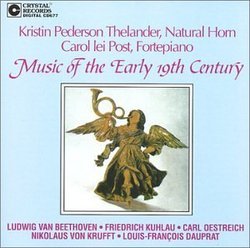| All Artists: Kristin Pederson Thelander (Natural Horn), Carol lei Post (Fortepiano), Friedrich Kuhlau Title: Music of the Early 19th Century Members Wishing: 0 Total Copies: 0 Label: Crystal Records Release Date: 12/12/1994 Genres: Dance & Electronic, Classical Styles: Chamber Music, Historical Periods, Classical (c.1770-1830) Number of Discs: 1 SwapaCD Credits: 1 UPC: 009414767721 |
Search - Kristin Pederson Thelander (Natural Horn), Carol lei Post (Fortepiano), Friedrich Kuhlau :: Music of the Early 19th Century
 | Kristin Pederson Thelander (Natural Horn), Carol lei Post (Fortepiano), Friedrich Kuhlau Music of the Early 19th Century Genres: Dance & Electronic, Classical
|
Larger Image |
CD Details |
CD ReviewsOutstanding example of natural horn playing Michael Simpson | Austin, TX USA | 07/27/2005 (4 out of 5 stars) "This CD, which I first heard on my local classical station, features five compositions played on a "natural horn" - a horn without valves. The performer tunes her pitches by positioning her hand in the bell of her instrument.
Beethoven intended both instruments to be equally prominent in his "Sonata for Fortepiano and Horn". Ms. Thelander's instrument is a replica of a 19th century natural horn. The fortepiano used for this recording is a replica instrument, tuned by an 18th century system. The result is an historical-sounding performance, with the fortepiano predominating more than a piano might in a modern setting. Both performers render polished, musical executions of this difficult chamber piece that features the lower range of the horn. Kuhlau, better known as a composer of works for flute, wrote an Andante and Polacca for horn and piano. I enjoyed this piece, though I wish Friedrich had achieved a better balance between its two movements. The three remaining compositions were written by two horn players (Oestreich and Dauprat) and a pianist (von Krufft). While these works are more obscure than the Beethoven (which is not exactly a staple in the French horn repertoire) they reflect a greater awareness of the musical qualities of the various timbres possible on the horn. In particular, the Rondo of Dauprat's Sonata features an extended passage for the horn that demonstrates the different timbres of each scale degree. As I noted above, the fortepiano tends to dominate the horn in several passages here. This is a minor quibble, and may reflect the historical reality of the instruments, or maybe the engineering of the recording. I recommend this CD for anyone interested in late classical music, and particularly to those folks interested in the French horn." |

 Track Listings (12) - Disc #1
Track Listings (12) - Disc #1